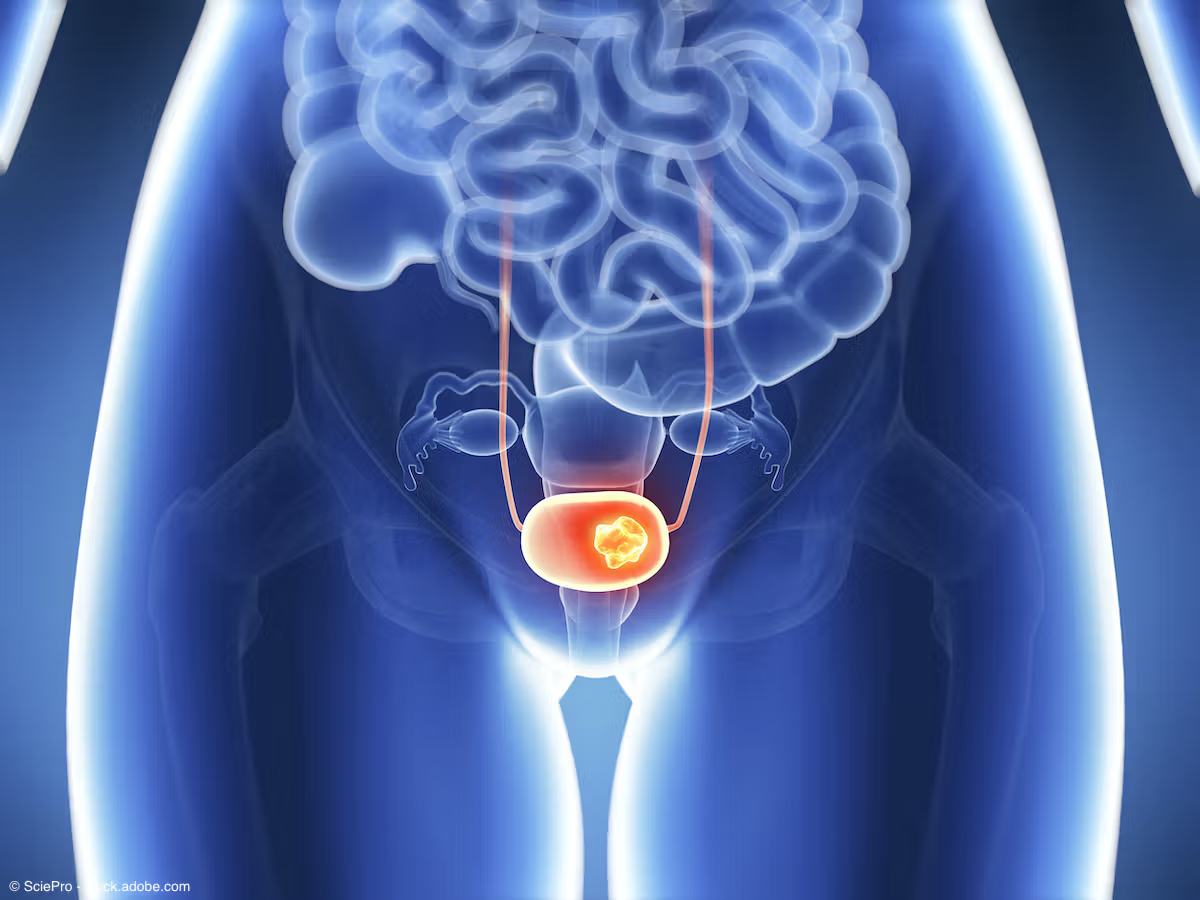Feature
Article
Exploring new avenues in non–muscle invasive bladder cancer treatment
Author(s):
Key Takeaways
- Bipolar resection and enhanced imaging are preferred for NMIBC assessment, reflecting a trend towards advanced diagnostic tools.
- Pembrolizumab offers a distinct safety profile for BCG-unresponsive patients, despite lower 1-year response rates compared to BCG.
Three recent expert-led Clinical Forums explored current challenges and advancements in the management of non–muscle invasive bladder cancer.
In February and March 2025 Urology Times®hosted Clinical Forum events in San Francisco, California; Houston, Texas; and Baltimore, Maryland. These discussions focused on current challenges and advancements in the management of non–muscle invasive bladder cancer (NMIBC), touching on approved therapies such as nadaofaragene firadenovec (Adstiladrin), nogapendekin alfa inbakicept (Anktiva), and pembrolizumab (Keytruda), along with investigational treatments such as sasanlimab. What follows is a summary of these discussions.
This summary was AI generated and edited by human editors for clarity.
Clinical Forum - Baltimore
Rian J. Dickstein, MD

Rian J. Dickstein, MD, medical director of the Bladder Cancer Program for Chesapeake Urology in Maryland, served as moderator for this forum. At the beginning of the discussion, various techniques used in the assessment of NMIBC were reviewed, highlighting the preference for bipolar resection over monopolar techniques among attendees. The use of enhanced imaging modalities, such as narrow band imaging, was also a topic of consensus, demonstrating a growing trend toward utilizing advanced diagnostic tools in the evaluation and management of bladder cancer.
Central to the discussion were various therapeutic strategies, particularly for patients who have not responded adequately to BCG treatments. One prominent therapy discussed was pembrolizumab. Though its 1-year response rates were considered lower compared to those of BCG, it was acknowledged that pembrolizumab offers a different safety profile, making it an important option to consider especially for patients with limited treatment alternatives.
A pivotal moment in the conversation was the overview of clinical trials that are currently influencing treatment paradigms. The CREST trial (NCT04165317), investigating the use of sasanlimab, was highlighted. Sasanlimab, a subcutaneously administered PD-1 inhibitor, potentially eliminates the need for intravenous infusions, streamlining the treatment process. The appeal of this trial lies not only in its innovative approach but also in the notion that it could allow urologists to manage therapy independently, crafting a more direct line of care for patients. With its recent completion, the anticipation surrounding the trial’s results reflects the significant interest in therapies that offer convenience and efficacy.
Another clinical trial presented during the discussion was the POTOMAC study (NCT03528694), which focused on the combination of durvalumab (Imfinzi) with BCG. Positive results from European counterparts of this trial set a strong precedent, instigating further investigation within the US. Although still in the early phases, initial findings from the US segment create an encouraging backdrop for adapting treatment strategies that integrate immunotherapeutic approaches alongside existing protocols like BCG.
Furthermore, there was substantial interest in new developments in bladder cancer treatment technologies. Nadofaragene firadenovec was mentioned as part of a growing array of innovative treatments. Trials involving nadofaragene are exploring its potential to elicit robust immune responses, representing a novel avenue in immunotherapy for patients who exhibit resistance to standard treatments.
The discussion also broached the subject of nogapendekin alfa inbakicept (Anktiva), an intravesical treatment based on interleukin-2 intended to augment the immune response within the bladder. Encouraging observances regarding its efficacy have fueled interest in conducting head-to-head trials against BCG to better define its role within treatment algorithms.
The roundtable also reflected concerns about the therapeutic landscape’s evolving nature. The shift from categorizing patients purely as BCG unresponsive to a more nuanced understanding of treatment unresponsiveness indicates ongoing deliberations about how to best approach therapy selection in bladder cancer. The necessity for rigorous clinical studies—especially those employing placebo-controlled or double-arm designs—was emphasized, as many recent approvals were achieved through single-arm trials, which may not provide sufficiently robust evidence for long-term treatment efficacy.
Amid these advances, participants expressed a shared concern regarding the logistical challenges that arise in deploying newer treatment modalities and ensuring they fit seamlessly into existing clinical workflows. Discussions regarding patient management also highlighted the importance of considering patient preferences and risk profiles when deciding on treatment pathways. An effective patient-centered approach is crucial to navigating the complexities of treatment, particularly when dealing with the uncertainties surrounding responses to various immunotherapies and chemotherapies.
Overall, the forum offered a comprehensive overview of the current state of bladder cancer treatment strategies, emphasizing the importance of collaboration, innovation, and patient-centered care in refining therapy protocols. The clinical trials discussed, including CREST and POTOMAC, along with emerging therapies like sasanlimab, pembrolizumab, nadofaragene, and Anktiva, reflect the dynamic landscape of bladder cancer management and the ongoing quest for improved patient outcomes. The dialogue reinforced the need for continued research and open communication among providers to ensure that advancements are effectively translated into clinical practice.
Clinical Forum – Houston
Raj Satkunasivam, MD, MS, FRCSC

Raj Satkunasivam, MD, MS, FRCSC, an associate professor and urologic oncologist with Houston Methodist, served as moderator for this forum. One focal point of the discussion was the definition and identification of patients deemed BCG-unresponsive. A critical component involves ensuring that these patients have undergone adequate treatment with BCG, which can be quantified using the "5 plus 2 rule." This guideline specifies that patients must receive 5 of 6 induction doses and 2 of 3 maintenance doses of BCG, alongside certain recurrence patterns—CIS (carcinoma in situ) recurrence within 12 months or TA (transitional cell carcinoma) recurrence within 6 months—to consider them as unresponsive. The need for proper identification of this patient group was seen as pivotal in attracting pharmaceutical interest to develop novel therapies.
The group noted ongoing trials aimed at this demographic, such as the EA8212 BRIDGE trial, which compares gemcitabine and docetaxel vs BCG in BCG-naive patients. This trial holds significance as it seeks to reserve BCG for patients who require it, maintaining its availability. The conversation also addressed the sourcing of BCG, especially the challenges associated with trials relying on different strains of BCG.
The discussion touched on new immunotherapeutic approaches, including the use of sasanlimab in the CREST clinical trial. Sasanlimab targets immune checkpoints, with the trial focusing on evaluating its efficacy. Another topic of interest was the TAR-200 platform, which is being studied in the SunRISe-3 trial and involves the delivery of erdafitinib, an FGFR receptor inhibitor, directly to the bladder in conjunction with BCG, or as monotherapy. This trial seeks to explore alternative administration routes and their potential benefits over systemic delivery methods, which have been associated with greater toxicity and require extensive monitoring.
The conversation shifted to practical challenges faced by oncology offices and urologists regarding the administration of these treatments. Participants acknowledged the difficulty in accommodating chemotherapy administration in various clinical settings, emphasizing the need for seamless operation between urology and oncology practices to facilitate the delivery of gemcitabine and docetaxel. Cost considerations, such as the affordability of certain therapies like gemcitabine and docetaxel, highlight a positive aspect of treatment access, but logistical hurdles persist.
Discussion participants emphasized the importance of keeping abreast of ongoing trials and data reporting from various studies like POTOMAC, which are expected to redefine treatment options in clinical practice. Notably, there was a strong consensus on the necessity for more effective trial designs that adequately address the needs of specific patient populations and adequately prove the efficacy and safety of new treatments.
Clinical Forum – San Francisco
Gautam Jayram, MD

Gautam Jayram, MD, a urologic oncologist and director of the Advanced Therapeutics Center in Nashville, Tennessee, served as moderator for this forum. At the forefront of the discussion was sasanlimab. The CREST trial was noted for its aim to establish how this therapy performs in combination with BCG remains the standard care for NMIBC, and the results from CREST are anticipated to provide insights into whether sasanlimab can improve outcomes for patients who are BCG unresponsive or naïve. Given that BCG treatment has become complicated by shortages and variations in patient adherence, finding effective complements to this therapy is a priority for urologists.
The experts also discussed the application of pembrolizumab, which may provide an effective treatment option for patients who cannot undergo surgery or those who have progressed after initial therapies. However, the conversation highlighted the importance of patient selection, as the effectiveness of pembrolizumab can vary based on tumor characteristics and patient health status. Clinical trial data continues to refine the understanding of pembrolizumab’s role in bladder cancer, suggesting it may serve best in a personalized treatment approach.
Another novel therapy discussed was Anktiva. The participants noted that incorporating various immunotherapies such as Anktiva alongside traditional treatments could improve patient outcomes. The group expressed the necessity of continuing to investigate combination therapies, particularly as evolving data emerges from ongoing clinical trials.
Throughout the discussion, the challenges of treating NMIBC were emphasized, particularly in the post-BCG setting. One of the difficulties noted was the issue of incomplete treatment courses for patients, which can occur due to adverse events or limitations in treatment availability. The speakers agreed that the lack of standardized adherence to recommended BCG protocols has led to variations in patient outcomes. As bladder cancer management continues to evolve with new pharmacological options, strategies must also be developed to ensure complete and consistent access to therapies, especially for patients at risk of recurrence after BCG treatment.
The experts acknowledged that although advances in treatment options through trials like CREST provide hope, they must also consider practical implications within clinical practice. Understanding how newly approved or experimental therapies could integrate with existing standards of care is crucial, as is assessing the long-term outcomes associated with these combinations. Complications arising from both systemic and local treatments—particularly with agents that can have significant adverse events—were emphasized as an important consideration.

















